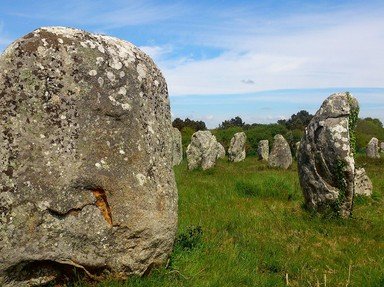Quiz Answer Key and Fun Facts
1. Our first silly Irishman probably shouldn't have been there, but hey, he's silly so what do you expect? Eoghan (pronounced Owen) ended up skiing on a 3000 meter thick ice sheet that covered most of Ireland during the last ice age. This ice age occurred during which geological epoch that ended about 10,000 BC or 12,000 BP?
2. The next Irishman is Seamus and he is studying prehistory at Dublin University. He keeps getting confused by all the different dating nomenclature like AD, BC, BCE, and CE. But what really confuses him is BP. What does BP stand for when speaking in geological or archeological terms?
3. So the first settlers in Ireland were leprechauns, right? Sorry, no. The oldest settlement discovered by archeology in Ireland is this place that sounds like something you might wear to the beach. Which site is it?
4. Our next Irishman, Taog, actually came from somewhere else and settled in what is now County Antrim around 8000 or 7000 BC, claiming Ireland as his new home. From which nearby neighbor do many historians postulate he probably came?
5. After the age of the hunter-gatherer came to an end in Ireland around 4000 BC, the next age began with the advent of farming and domesticated animals. To which age did our farming Irish couple Ciaran and Caitlin belong?
6. With the advent of farming and animal domestication, populations became more settled and less migratory leading to more ornate burial practices. Ireland is covered with many different examples of prehistoric burial structures that used what type of rock(s) that basically means 'large stone'?
7. The next age of human existence in Ireland was the Bronze Age (2500 to 500 BC). It was characterized by the introduction of flat axes that bear a specific name. Which word is this that has become a generic term for small Irish towns as well as the name of several specific Irish towns? (Hint: Brian Friel set many of his plays in this fictional town of Donegal County.)
8. One of the greatest finds that dates back to the Iron Age in Ireland is the Broighter Hoard, a hoard of gold artefacts dating to the 1st century BC. The artistry of the artefacts is considered one of the "finest examples" of what style of art more closely associated with Iron Age mainland Europe?
9. While having a pint in a pub in Dublin, local Colin begins to spin a yarn about the Romans in Ireland. He says evidence has been found of as many as ten Roman forts in southern Ireland dating from around 100 AD, demonstrating that the Romans were a force in prehistoric Ireland for at least 100 years. Does the historical evidence support this seemingly fanciful tale?
10. While visiting Dublin's St. Patrick's Cathedral, Father Patrick Cleary tells you of Ireland's religious past. He tells you the introduction of what religion brought an end to prehistoric Ireland because it introduced some written records?
Source: Author
tazman6619
This quiz was reviewed by FunTrivia editor
bloomsby before going online.
Any errors found in FunTrivia content are routinely corrected through our feedback system.
